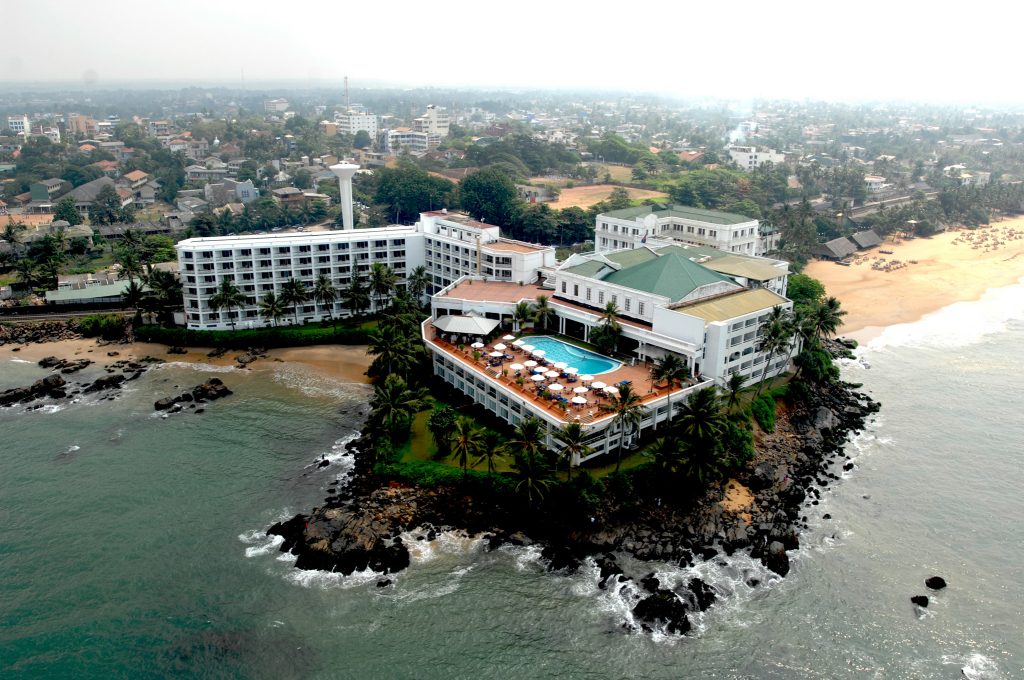The Mount Lavinia Hotel, in Mount Lavinia, Sri Lanka, is a 275-room hotel, situated at 100 Hotel Road in Mount Lavinia. It is recognised as one of the oldest and most famous hotels in the country. It has been continuously operating as a hotel since 1947, but was initially constructed as the Governor’s residence in 1806.
In 1805 Sir Thomas Maitland was appointed as the second Governor of British Ceylon. He had acquired land at “Galkissa” (Mount Lavinia) and decided in 1806 to construct a personal residence there.
Legend has it that at a welcoming party held in his honour upon his arrival in the island he saw Lovina Aponsuwa, a local mestizo dancer, whose father was the headman of the dancing troupe. Maitland fell in love with Aponsuwa, who had been born to Portuguese and Sinhalese parents. During construction, the governor arranged to build a secret tunnel between Aponsuwa’s house which was located nearby, one end inside her house and the other inside his wine cellar, so that the lovers could meet in secret.
Sir James Mackintosh, a friend of the Governor, wrote in 1810 that it was “a bungalow of one storey, rustic on the outside, but handsomely laid out, and furnished beautifully”.
Sir Thomas Maitland was recalled from Ceylon in 1811 and appointed the Governor of Malta, where he died a bachelor.
The statue of ‘Lady’ Lavinia, as the girl later became known, can be found in the middle of a water fountain at the entrance of the hotel.
The next Governor, Sir Robert Brownrigg recommended a further purchase of the surrounding land, 35 acres (14 ha) from 14 landowners for 18,000 Rix dollars.
Sir Edward Barnes during his second term as Governor, undertook significant extensions and improvements to the building. “Barnes set to work on his grand plans. Mount Lavinia was to be his ultimate creation; a magnificent residence fit for the Grand Master, such as Versailles was to Louis XIV”.
British military engineers redesigned the house on the lines of an Italian villa. Captain Edward Sanderson of the Royal Engineers, was the designer and master builder under Barnes’ watchful eye. The building was modelled on the ‘Banqueting House’ in Whitehall, a creation of architect Inigo Jones, also known as the ‘English Palace’. The Banqueting House was refurbished by architect Sir John Soane. “Not only does the date of the refacing of the Banqueting House coincide perfectly with the building of Mount Lavinia but a marked similarity in style is also apparent between the two buildings. Inigo Jones had used the Ionic and Corinthian orders, the height of urban sophistication. At Mount Lavinia, which offered a country setting, Sanderson used the simpler Doric order and superimposed the Ionic. This pattern had been used by Palladio in building his Palazzo Chiericati in Vicenza, Italy.”
The works were completed in 1830 however in 1831 Barnes was appointed as Commander in-Chief in India. His successor Sir Robert Wilmot-Horton chose not to reside at Mount Lavinia and it was therefore recommended that the building be disposed of. In 1842 the British government sold the building at auction, with Rev. Dr. John MacVicar, the Colonial Chaplain purchasing it. The mansion was subsequently converted into an asylum for the insane.
In 1877 the government constructed a railway line along the coast (the second railway line in Ceylon). The railway line passed in front of Mount Lavinia, connecting the house directly to the harbor at Colombo. Seeing the potential for profit, developers bought the dilapidated mansion and turned it into an opulent hotel, The Mount Lavinia Grand Hotel. Later two additional wings were added to the building.
In 1927 the hotel was purchased by Arthur Ephraums, the owner of several other prestigious hotels, The Globe Hotel, The Bristol Hotel and the Whitehorse Hotel in Colombo, and was managed by Cargills & Co.
In 1939 following the commencement of World War II Ceylon, the center of the British Empire’s rubber supply, quickly became a priority for the Allies and a target for the Axis forces. The Mount Lavinia Hotel was commandeered as a supply base and military hospital by the British Army.
After the war ended in 1947, the hotel was re-established. If you have seen or heard of the film “The Bridge on the River Kwai”, you will notice some scenes filmed at Mount Lavinia Hotel.
The hotel was sold in 1944 to Ceylon Hotels Corporation Ltd and later in 1948, the year in which Ceylon achieved Independence; the hotel was sold to H. J. Pilbrow and then sold again in 1955 to Mr. P. A. Ediriweera.
In 1957 a number of scenes in the film, The Bridge on the River Kwai, were filmed at the hotel.
In 1975 Mr. U. K. Edmund purchased the hotel becoming the Director and Chairman of the Hotel until his death in 1985, when the property then passed to his son, Sanath Ukwatte, who is the present Chairman of the Hotel Group.

In January 2011 four blue plaques were installed at the hotel’s entrance, commemorating Sir Thomas Maitland, Sir Robert Brownrigg, Sir Edward Paget and Sir Edward Barnes, all of whom resided in the building when it was the Governors residence.
Credit – Wikipedia





















Loading…
Loading…